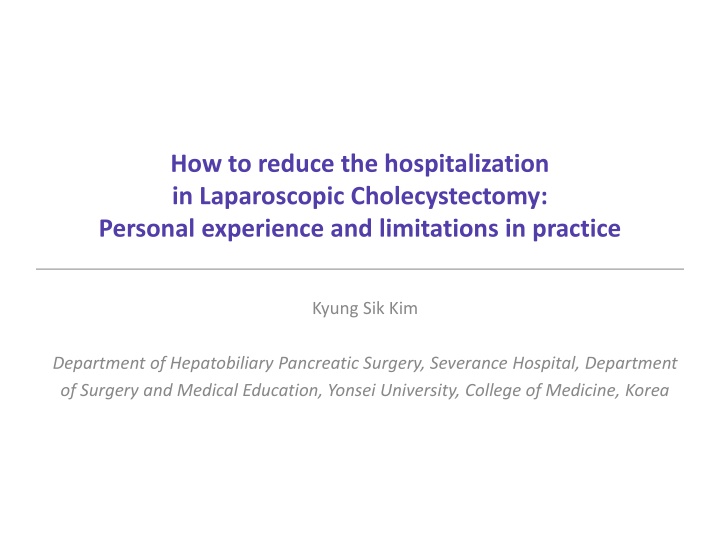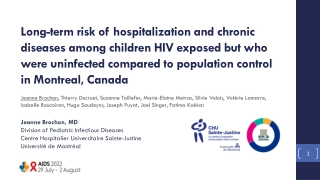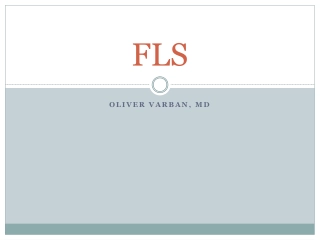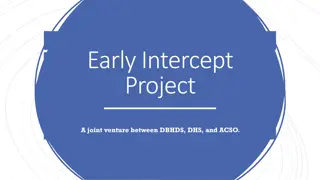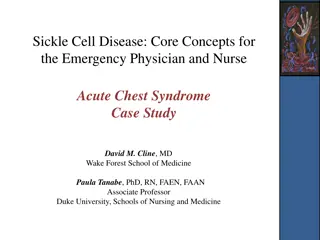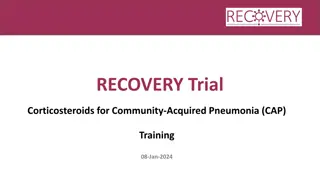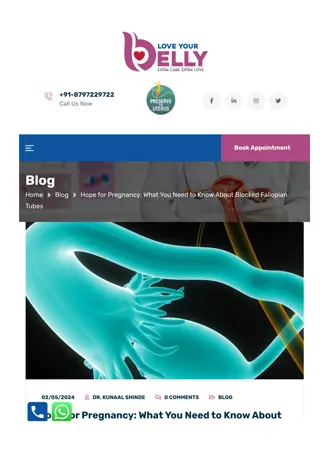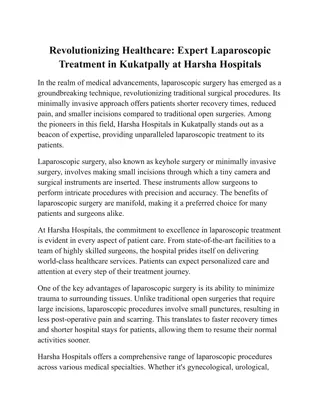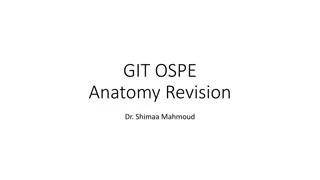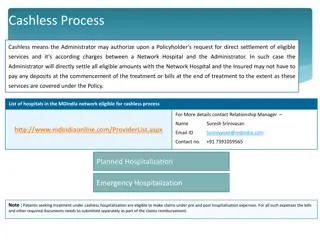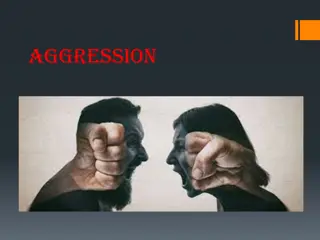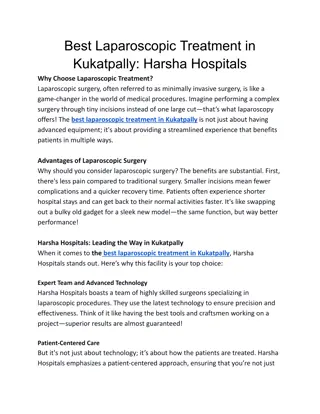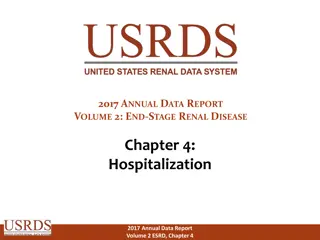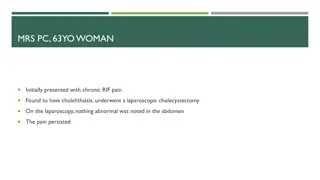Reducing Hospitalization in Laparoscopic Cholecystectomy: Factors and Findings
This study examines influencing factors affecting post-op hospital stay after laparoscopic cholecystectomy, sharing insights and outcomes from a retrospective multicenter analysis. Discover strategies for reducing hospitalization based on personal experiences and clinical pathways in gallbladder surgery.
Uploaded on Mar 01, 2025 | 3 Views
Download Presentation

Please find below an Image/Link to download the presentation.
The content on the website is provided AS IS for your information and personal use only. It may not be sold, licensed, or shared on other websites without obtaining consent from the author.If you encounter any issues during the download, it is possible that the publisher has removed the file from their server.
You are allowed to download the files provided on this website for personal or commercial use, subject to the condition that they are used lawfully. All files are the property of their respective owners.
The content on the website is provided AS IS for your information and personal use only. It may not be sold, licensed, or shared on other websites without obtaining consent from the author.
E N D
Presentation Transcript
How to reduce the hospitalization in Laparoscopic Cholecystectomy: Personal experience and limitations in practice Kyung Sik Kim Department of Hepatobiliary Pancreatic Surgery, Severance Hospital, Department of Surgery and Medical Education, Yonsei University, College of Medicine, Korea
Table of contents Introduction Influencing factors on postoperative hospital stay Usefulness of critical pathway Patient satisfaction with critical pathway Conclusion
Introduction Advantages of laparoscopic cholecystectomy Less postoperative pain Shorter operation time Lower rate of postoperative complications Shorter hospital stay Clinical pathway in laparoscopic cholecystectomy High success rates (Topal et al. Surg Endosc 2007;21:1142-6) Day-surgery vs. overnight surgery No statistical differences (Vaughan et al. The Cochrane Library 2013) All trials at high risk of bias
Introduction Factors associated with delayed hospital stay Advanced age, delayed diet resumption, greater need for oral analgesia Tsang et al. Asian J Surg 2007;30:23-8 ASA score, LC difficulty Morimoto et al. Asian J Endos Surg 2015;8:289-95 Intraoperative complications Cheng et al. Surg Endosc 2008;22:1283-9 Aim Share personal experiences in how to reduce hospitalization
Influencing factors on postoperative hospital stay Retrospective multicenter analysis August 1, 2012 and August 31, 2012 336 consecutive patients underwent LC for benign gallbladder disease at 8 different hospitals Severance Hospital, Gangnam Severance Hospital, Wonju Severance Christian Hospital, Inchon & Daejeon St. Mary Hospital, National Health Insurance Serivce Ilsan Hospital, Seoul Nanitional University Bundang Hospital, and Guro Hospital
Results p Multivariate logistic regression Odds ratio 95% CI p POD 2days (N=225) 45 (20.0%) 1.030 POD > 2days (n=111) 36 (32.4%) 1.005-1.045 p POD 2days (n=225) 45 (14-190) Operation time (min) POD > 2days (n=111) 77 (16-371) Age 65 yea rs Male gender 0.012 Operation time , min (range) Perioperative transfusion <0.001 <0.001 85 (37.8%) 56 (50.5%) 0.036 1 (0.5%) 6 (5.6%) 0.006 25.3 15.2 24.2 3.2 BMI (kg/m2) <0.001 0.618 Emergency operation 6.104 2.293-16.250 Emergency operation 9 (4.0%) 23 (20.7%) <0.001 DM 22 (10.0%) 22 (20.2%) 0.011 Albumin <3.0g/dL Smoking 4 (1.8%) 8 (7.3%) 0.024 Operation history Acute inflammation Gallbladder stone Surgical site infection 36 (16.0%) 20 (18.0%) 0.782 Age (years) 0.014 1.025 1.005-1.045 25 (11.2%) 25 (22.5%) 0.010 24 (10.7%) 47 (42.3%) <0.001 ASA score 0.022 1 122 (54.2%) 2.341 40 (36.0%) 0.003 61 (27.1%) 31 (28.2%) 0.837 Smoking 1.129-4.853 2 87 (38.7%) 63 (56.8%) 2 (0.9%) 5 (4.6%) 0.041 3 16 (7.1%) 7 (6.3%) *Influencing factors on postoperative hospital stay length: Perioperative factors 4 0 (0.0%) 1 (0.9%) *Influencing factors on postoperative hospital stay length: Patient factors Chong et al. Korean J Hepatobiliary Pancreat Surg 2016;20:12-6
Influencing factors on postoperative hospital stay Conclusion Older patients with longer operation time are likely to be in late discharge group Although not determined to be independent factors, preoperative albumin level and strict perioperative sugar control needs further investigation as to influence on hospital stay Limitations Bias inherent to retrospective nature of the design Short follow-up period Lack of discharge protocol among the participating hospitals
Usefulness of critical pathway Optimal management of discharge protocol Implementation of critical pathway (June, 2010) Inter-departmental networking is essential Surgeons Anesthesiologists Residents Nurses Admissions Quality improvement
Usefulness of critical pathway Inclusion criteria Exclusion criteria 16 age 70 Acute cholecystitis, GB empyema GB stone, GB polyp CBD stone Visit via OPD Visit via ER Agree with CP Co-operation case Cardiovascular disease Pulmonary disease Previous history affecting laparoscopic surgery Open conversion OP complication; biliary tract injury Drain insertion Chong et al. J Minim Invasive Surg 2016 Accepted Post op hemodynamic unstability
Usefulness of critical pathway Chong et al. J Minim Invasive Surg 2016 Accepted
Usefulness of critical pathway Retrospective review From June 2010 to July 2011 57 patients in CP group vs. 91 patients in non-CP group Primary outcome Difference in length of hospital stay Difference in medical costs
Usefulness of critical pathway Chong et al. J Minim Invasive Surg 2016 Accepted
Patient satisfaction with critical pathway Critical factor in successful implementation Which factor influences patient satisfaction with critical pathway???
Patient satisfaction with critical pathway Retrospective review From January 2011 to September 2015 253 patients enrolled into critical pathway Survey based Five-point Likert response set Ranging from 1(never) to 5(very often)
Patient satisfaction with critical pathway Exploratory factor analysis Principle component analysis for extraction Kaiser-Meyer-Olkin index: 0.859 Barlett s test of sphericity: p<0.001 Factor 1: Satisfaction with explanation regarding the operation Cronbach s : 0.939 Factor 2: Physical well-being and overall satisfaction in regards to operation Cronbach s : 0.877 Factor 3: Overall satisfaction with CP Cronbach s : 0.815
Patient satisfaction with critical pathway t p Multiple regression analysis Factor 1 0.410 6.060 <0.001 Factor 2 0.008 0.119 0.906 Factor 3 (dependent variable) Factor 1: Satisfaction with explanation regarding the operation Overall satisfaction of CP: 4.25/5.00 (85%)
Patient satisfaction with critical pathway Drop-out from CP: 24 (9.5%) patients Open drain Postoperative pain Postoperative nausea/vomiting Postoperative fever Reported compliance rate with CP: 66 75% Muller et al. Langenbecks Arch Surg 2009;394:31-39 Soria et al. Am Surg 2005;71:40-4
Conclusion Chong et al. J Minim Invasive Surg 2016 Accepted
Conclusion Reducing hospitalization in laparoscopic cholecystectomy Increased available hospital resources Greater patient satisfaction Reduced medical costs Lesson learned Detailed explanation regarding the operation is the key to compliance Future More multicenter studies with follow-up survey are needed
Consensus protocols and comprehensive patient and health professional education can overcome multiple barriers by managing expectations and providing a uniform plan and timeline for care. (Calland et al. Annals of surgery 2001;233:704-15)
